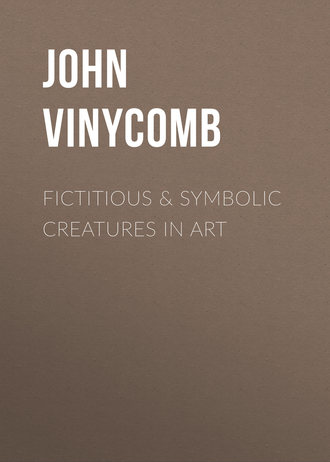 полная версия
полная версияFictitious & Symbolic Creatures in Art
Charles Boutell, M.A., “English Heraldry,” p. 247, says, regarding angels used as supporters to the armorial shield: “The introduction of angelic figures which might have the appearance of acting as ‘guardian angels’ in their care of shields of arms, was in accordance with the feelings of the early days of English heraldry; and, while it took a part in leading the way to the systematic use of regular supporters, it served to show the high esteem and honour in which armorial insignia were held by our ancestors in those ages.” And reference is made to examples sculptured in the noble timber roof of Westminster Hall and elsewhere. As an example we give the shield of arms of the Abbey of St. Albans.

Kneeling Angel Supporter.
Figures of angels holding shields of arms, each figure having a shield in front of its breast, are frequently sculptured in Gothic churches. They appear on seals, as on that of Henry of Lancaster about 1350, which has the figure of an angel on each side of it. The shield of Richard II. at Westminster Hall, bearing the arms of France ancient and England quarterly, is supported by angels, which, if not rather ornamental than heraldic, were possibly intended to denote his claim to the crown of France, being the supporters of the Royal arms of that kingdom. Upon his Great Seal other supporters are used. There are also instances of the shield of Henry VI. being supported by angels, but they are by some authorities considered as purely religious symbols rather than heraldic.
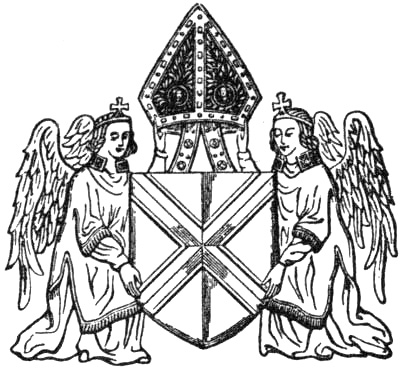
Arms of the Abbey of St. Albans.
The supporters of the King of France were two angels standing on clouds, all proper, vested with taberts of the arms, the dexter France, the sinister Navarre, each holding a banner of the same arms affixed to a tilting-spear, and the cri de guerre or motto, “Mont-joye et St. Denis.” The shield bears the impaled arms of France and Navarre with several orders of knighthood, helmet, mantling and other accessories, all with a pavilion mantle.
Although Francis II., Charles IX., Henry III. and IV. and Louis XIII. had special supporters of their arms, yet they did not exclude the two angels of Charles VI., which were considered as the ordinary supporters of the kingdom of France. Louis XIV., Louis XV. and Louis XVI. never used any others.
Verstegan quaintly says that Egbert was “chiefly moved” to call his kingdom England “in respect of Pope Gregory changing the name of Engelisce into Angellyke,” and this “may have moved our kings upon their best gold coins to set the image of an angel.”4
“… Shake the bagsOf hoarding abbots; their imprisoned angelsSet them at liberty.”Shakespeare, King John, iii. 3.The gold coin was named from the fact that on one side of it was a representation of the archangel in conflict with the dragon (Rev. xii. 7). The reverse had a ship. It was introduced into England by Edward IV. in 1456. Between his reign and that of Charles I. it varied in value from 6s. 8d. to 10s.
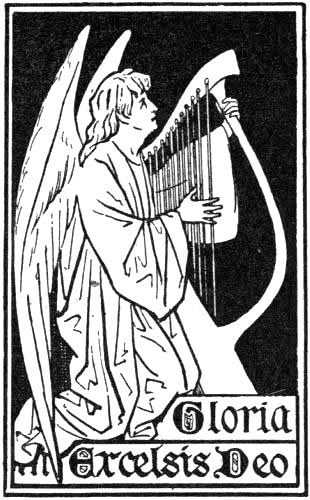
Cherubim and Seraphim in Heraldry
“On cherubim and seraphimFull royally he rode.”Steenhold.“What, always dreaming over heavenly things,Like angel heads in stone wish pigeon wings.”Cowper, “Conversation.”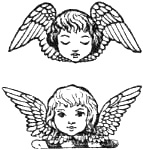
Cherubs’ Heads.
In heraldry A Cherub (plural Cherubim) is always represented as the head of an infant between a pair of wings, usually termed a “cherub’s head.”
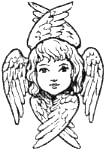
A Seraph’s Head.
A Seraph (plural Seraphim), in like manner, is always depicted as the head of a child, but with three pairs of wings; the two uppermost and the two lowermost are contrarily crossed, or in saltire; the two middlemost are displayed.
Clavering, of Callaby Castle, Northumberland, bears for crest a cherub’s head with wings erect. Motto: cœlos volens.
On funereal achievements, setting forth the rank and circumstance of the deceased, it is usual to place over the lozenge-shaped shield containing arms of a woman, whether spinster, wife, or widow, a cherub’s head, and knots or bows of ribbon in place of crests, helmets, or its mantlings, which, according to heraldic law, cannot be borne by any woman, sovereign princesses only excepted.

Arms—Azure a chevron argent between three cherubs’ heads of the last.
In representing the cherubim by infants’ winged heads, the early painters meant them to be emblematic of a pure spirit glowing with love and intelligence, the head the seat of the soul, and the wings attribute of swiftness and spirit alone retained.
The body or limbs of the cherub and seraph are never shown in heraldry, for what reason it is difficult to say, unless it be from the ambiguity of the descriptions in the sacred writings and consequent difficulty of representing them. The heralds adopted the figure of speech termed synecdoche, which adopts a part to represent the whole.
Sir Joshua Reynolds has embodied the modern conception in his exquisite painting of cherubs’ heads, Portrait Studies of Frances Isabella Ker, daughter of Lord William Gordon, now in the National Collection. It represents five infants’ heads with wings, in different positions, floating among clouds. This idea of the cherub seems to have found ready acceptance with poets and painters. Shakespeare sings:
“Look how the floor of heavenIs thick inlaid with patines of bright gold:There’s not the smallest orb which thou beholdestBut in his motion like an angel sings,Still quiring to the young-eyed cherubim—Such harmony is in immortal souls:But while this muddy vesture of decayDoth grossly close it in, we cannot hear it.”Many of the painters of the period of the Renaissance represented the cherub similarly to those in Reynolds’ picture. They were also in the habit of introducing into their pictures of sacred subjects nude youthful winged figures, “celestial loves,” sporting in clouds around the principal figure or figures, or assisting in some act that is being done. Thus Spenser invests “The Queen of Beauty and of Love the Mother” with a troop of these little loves, “Cupid, their elder brother.”
“And all about her neck and shoulders flewA flock of little loves, and sports and joysWith nimble wings of gold and purple hue;Whose shapes seemed not like to terrestrial boys,But like to angels playing heavenly toys.” Faerie Queen, Book x. cant. x. p. 153.These must not, however, be confounded with the cherub and seraph of Scripture. It was a thoroughly pagan idea, borrowed from classic mythology, and unworthy of Christian Art. It soon degenerated into “earthly loves” and “cupids,” or amorini as they were termed and as we now understand them.
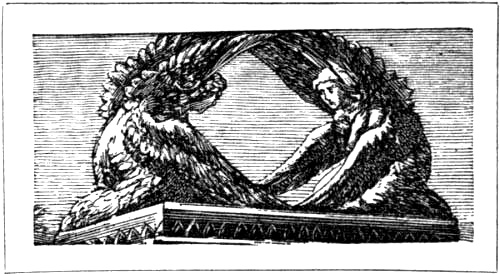
Cherubim and Seraphim of Scripture
In Ecclesiastical Art literal renderings of the descriptions contained in the Old Testament and the Apocalypse are not of unfrequent use. A more lengthened reference to these great Hebrew symbolic beings will not be considered out of place, as there is great doubt and uncertainty as to their forms.
These mystic symbolic beings were familiar to all the patriarchs—from Adam, who gazed upon them in Paradise, and against whom on his expulsion they stood with flaming sword, turning every way to bar his return—to Moses, who trembled before it on Mount Sinai; while to the Priests and Levites, the custodians of the Ark of the Covenant in the Tabernacle, the cherubim remained the sacred guardians in the Holy of Holies of the palladium of the national faith and liberties during the brightest and, as it has been termed, the most heroic period of Jewish history.

Angel crest of Tuite, Bart. co. Tip.
Josephus, the more effectually to excite respect for the great Hebrew symbol in the minds of his readers, purposely throws over it the veil of obscurity. He says: “The cherubim are winged creatures, but the form of them does not resemble that of any living creature seen by man.” In the works of Philo Judæus there is an express dissertation upon the cherubim. The learned Brochart and many others have attempted to elucidate the subject to little purpose. The ambiguity which always accompanies a written description of objects with which we are imperfectly acquainted applies with greater force to this mysterious being combining so many apparently conflicting attributes.
To the prophetic vision of Ezekiel, the description of which, in the opinion of competent critics, excels in grandeur of idea and energy of expression the most celebrated writers of ancient and modern times, the reader is referred, as it supplies at first hand almost all that can be known concerning the fearful form of the cherubim.
The four living creatures that support the throne of God exhibited to Ezekiel a fourfold aspect; they had each the face of a man, the face of a lion, and the face of an ox; they also had the face of an eagle. They had each four wings; they had the hands of a man under their wings. “Two wings of every one were joined one to the other, and two covered their bodies.” They were accompanied by wheels which “went upon their four sides, and they turned not when they went”; “and their whole body, and their backs, and their hands, and their wings, and their wheels were full of eyes”; “and the living creatures ran and returned as the appearance of a flash of lightning.” Such is a concise description of their appearance as set forth in Ezekiel (chap. i.).
“This wonderful and mysterious hieroglyph must be considered as a striking and expressive emblem of the guardian vigilance of providence, all-seeing and omniscient; while the number of wings exhibit to us direct symbols of that powerful, that all-pervading spirit which, while it darts through nature at a glance, is everywhere present to protect and defend us” (Dideron).
So attached were the Jews to this celestial symbol that when Solomon erected that stupendous temple which continued the glory and boast of the Hebrew nation for so many ages, we are told (1 Kings, vi. 29, viii. 6, 7), he carved all the walls of the house round about with the sculptured figures of the cherubim, and on each side of the ark was a cherub of gold plated upon olive wood fifteen feet high, with their faces to the light, their expanded wings embracing the whole space of the sacred enclosure, serving as a visible sign or symbol of God’s immediate presence, whence the saying of David, “God sitteth between the cherubim” (Ps. xcix. 1). In this place God perpetually resided in the form of a bright cloud or shining luminous body, termed “shechinah,” whence the divine oracles were audibly delivered.
Milton gives the following description of the Seraph Raphael:
“At once on the eastern cliff of ParadiseHe lights, and to his proper shape returnsA seraph wing’d; six wings he wore to shadeHis lineaments divine; the pair that cladEach shoulder broad came mantling o’er his breastWith regal ornament: the middle pairGirt like a starry zone his waist, and roundSkirted his loins and thighs with downy goldAnd colours dipped in heaven; the third, his feetShadows from either heel with feather’d mailSky tinctured grain. Like Maia’s son he stoodAnd shook his plumes, that heavenly fragrance fill’dThe circuit wide.” Paradise Lost, Book v.The cherub is traditionally regarded as a celestial spirit which in the hierarchy is placed next in order to the seraphim. All the several descriptions which the Scripture gives us of cherubim differ from one another, as they are described in the shapes of men, eagles, oxen, lions, and in a composition of all these figures put together. The hieroglyphical representations in the embroidery upon the curtains of the tabernacle were called by Moses (Ex. xxvi. 1) “cherubim of cunning work” (Calmet).
The seraphim are regarded as an order of angels distinguished for fervent zeal and religious ardour. The word means “burning,” i.e., with Divine Love.
The seraphim are described by Isaiah (vi. 1-3): “I saw also the Lord sitting upon a throne, high and lifted up, and his train filled the temple. Above it stood the seraphim: each one had six wings; with twain he covered his face, and with twain he covered his feet, and with twain he did fly. And one cried to another and said, Holy, Holy, Holy, is the Lord of Hosts: the whole earth is full of his glory.” And in Revelation (iv. 6): “Round about the throne were four beasts full of eyes before and behind, and the first beast was like a lion, and the second beast like a calf, and the third beast had a face as a man, and the fourth beast was like a flying eagle. And the four beasts had each of them six wings about him, and they were full of eyes within.” It will be noticed that these descriptions differ from that of Ezekiel, not only in the number of wings, but also in the individuality of each beast being separate and independent, not compounded of the four.
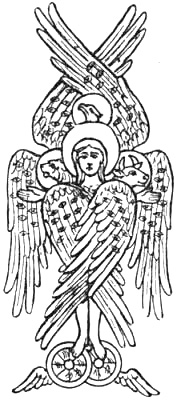
Tetramorph.
Several forms of these mystical creatures, says Audsley, have been devised by the early mediæval artists; those which display the entire forms of the man, the lion, the ox, and the eagle, all winged and invested with the nimbus, appear to have been most frequently made use of. They are to be met with formed of the heads of the mystical creatures on bodies or half-bodies of winged human figures; at other times we find them comprised in the heads and wings only of the four symbolic creatures. Sometimes they are found united and forming one mysterious being called the Tetramorph with four heads and numerous wings covered with eyes, the feet resting on wheels, which are also winged. The example is taken from a Byzantine mosaic in the convent of Vatopedi, on Mount Athos.
Pugin’s “Glossary of Ecclesiastical Ornament and Costume” says the cherubim are frequently represented of a bright red colour to set forth the intensity of divine love, and usually standing upon wheels, in reference to the vision of the prophet Ezekiel.
Cherubim and seraphim seem always vested in the alb or tunic, and a scarf tied in a knot round the neck.
Emblems of the Four Evangelists
The winged living figures, symbols of the evangelists, which are most frequently met with, and which have ever been most in favour with Early Christian artists, appear to have been used at a very early date. They are taken from the vision of Ezekiel and the Revelation of St. John. “The writings of St. Jerome,” says Audsley, “in the beginning of the fifth century gave to artists authority for the appropriation of the four creatures to the evangelists,” and for reasons which are there given at length.
St. Matthew: Winged Man, Incarnation.—To St. Matthew was given the creature in human likeness, because he commences his gospel with the human generation of Christ, and because in his writings the human nature of Our Lord is more dwelt upon than the divine.
St. Mark: Winged Lion, The Resurrection.—The Lion was the symbol of St. Mark, who opens his gospel with the mission of John the Baptist, “the voice of one crying in the wilderness.” He also sets forth the royal dignity of Christ and dwells upon His power manifested in the resurrection from the dead. The lion was accepted in early times as a symbol of the resurrection because the young lion was believed always to be born dead, but was awakened to vitality by the breath, the tongue, and roaring of its sire.
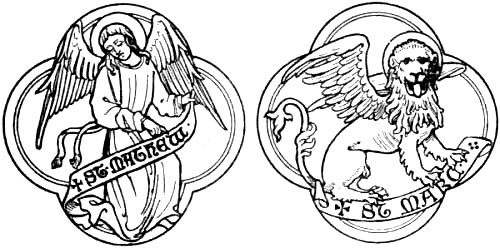
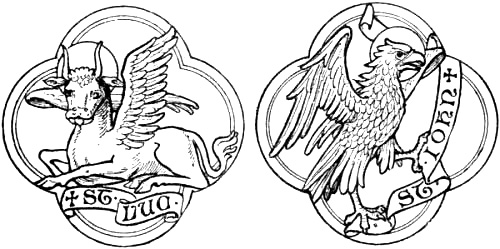
St. Luke: Winged Ox, Passion.—The form of the ox, the beast of sacrifice, fitly sets forth the sacred office, and also the atonement for sin by blood, on which, in his gospel, he particularly dwells.
St. John: The Eagle, Ascension.—The eagle was allotted to St. John because, as the eagle soars towards heaven, he soared in spirit upwards to the heaven of heavens to bring back to earth revelation of sublime and awful mysteries.
Independently of their reference to the four evangelists these figures sometimes refer to the Incarnation, the Passion, the Resurrection, and the Ascension.
Sedulius, a priest and poet of the fifth century, says much the same in the following verse:
Hoc Matthæus agens, Hominem generaliter implet:Marcus ut alta fremit vox per deserta Leonis:Jura sacerdotis Lucas tenet ore Juvenci:More volens Aquilæ verbo petit astra Johannes.The Lion of St. Mark.—In the ninth century the rapidly rising State of Venice was dignified by the reception of the relics of St. Mark, transported thither from Alexandria. “Few patron saints,” says Theodore A. Buckley, “enjoy a greater popularity, whether socially or locally exemplified. His lion was emblazoned on the standard of the Republic, and stamped on the current coins, while his name was identified with the pride, the power, and glory of all Venice.”5
Emblems of the evangelists do not often appear in heraldry.
Walter Reynolds, Archbishop of Canterbury, according to a manuscript at Lambeth (executed for Archbishop Laud), bore azure on a cross or, between the symbols of the evangelists of the last, four lions rampant gules.
The Freemasons appear to use a similar coat of arms upon their seal, viz., a cross between the emblems of the four evangelists, and for supporters two cherubims, all proper.

The Lion of St. Mark, Venice.
Chimerical Creatures of the Dragon and Serpent kind

The Dragon
“The scaly monster of a dragon, coiledFull in the central field—unspeakable,With eyes oblique retorted, that askantShot gleaming fire.”Hesiod.—“The Shield of Hercules.”The dragon is the most interesting and most frequently seen of all chimerical figures, and it is a remarkable fact that such a creature appears at an early period of the world’s history to have been known in the East and in countries widely separated. Long anterior to the dawn of civilisation in the West of Europe, even in far-off China and Japan in the extreme East of Asia we find the dragon delineated in very much the same form in which it appears in our national heraldry.
The ancients conceived it as the embodiment of malignant and destructive power, and with attributes of the most terrible kind. Classic story makes us acquainted with many dreadful monsters of the dragon kind, to which reference will afterwards be more particularly made.
It is often argued that the monsters of tradition are but the personification of solar influences, storms, the desert wind, the great deeps, rivers inundating their banks, or other violent phenomena of nature, and so, no doubt, they are, and have been; but the strange fact remains that the same draconic form with slight modifications constantly appears as the type of the thing most dreaded, and instead of melting into an abstraction and dying out of view, it has remained from age to age, in form, distinctly a ferocious flying reptile, until in the opinion of many the tradition has been justified by prosaic science. It is surprising to find that the popular conception of the dragon—founded on tradition, passed on through hundreds of generations—not only retains its identity, but bears a startling resemblance to the original antediluvian saurians, whose fossil remains now come to light through geological research, almost proving the marvellous power of tradition and the veracity of those who passed it on.
Mr. Moncure Conway (“Demonology, or Devil Lore”) says: “The opinion has steadily gained that the conventional dragon is the traditional form of some huge saurian. It has been suggested that some of those extinct saurians may have been contemporaneous with the earliest men, and that traditions of conflicts with them, transmitted orally and pictorially, have resulted in preserving their forms in fable proximately.”
“Among the geological specimens in the British Museum,” says Hugh Miller, “the visitor sees shapes that more than rival in strangeness the great dragons and griffins of mediæval legends; enormous jaws, bristling with pointed teeth, gape horrid, in stone, under staring eye-sockets a foot in diameter; and necks that half equal in length the entire body of a boa-constrictor. And here we see a winged dragon that, armed with sharp teeth and strong claws, has careered through the air on leathern wings like those of a bat.” We are also told in the sacred Scriptures by Moses of “fiery serpents,” and by Isaiah of “a fiery flying serpent.” Other monsters—dragons, cockatrices, and some of whose form we have no conception—are also mentioned. Euripides describes a dragon or snake breathing forth fire and slaughter, and rowing its way with its wings. It is evident that such a creature may at one time have existed. Looking at the widespread belief in dragons, there seems little doubt that the semi-myth of to-day is the traditional successor of a really once-existent animal, whose huge size, snake-like appearance, and possibly dangerous powers of offence made him so terrible that the earlier races of mankind adopted him unanimously as the most fearful embodiment of animal ferocity to be found.
One of the latest acquisitions in the Natural History Museum, South Kensington, is the skeleton of that enormous creature the long-limbed dinosaur (Diplodicus Carnegii), recently discovered in America, eighty-nine feet in length from the head to the tip of the tail, the huge bulky framework of the monster measuring eleven feet in height at the shoulder. The enormous length of its neck and tail, with relatively small head, would indicate it to be an amphibious inhabitant of the waters, feeding on the vegetation growing in its depths.
Mr. Moncure Conway, in his remarkable work, “Demonology, or Devil Lore,” describes all intermediate stages between demon and devil under the head of dragon. This he believes to be the only fabulous form which accurately describes all the transitions. Throughout all the representations of the dragon one feature is common, and that is the idealised serpent. The dragon possesses all the properties of the demon along with that of harmfulness, but differs from the devil in not having the desire of doing evil. The dragon in mythology is the combination of every bad feature in nature, all of which is combined into one horrible whole. “The modern conventional dragon,” says Mr. Conway, “is a terrible monster. His body is partially green, with memories of the sea and of slime, and partly brown or dark, with lingering shadows of storm-clouds. The lightning flames still in his red eyes, and flashes from his fire-breathing mouth. The thunderbolt of Jove, the spear of Woden, are in the barbed point of his tail. His huge wings—bat-like and spiked—sum up all the mysteries of extinct harpies and vampires. Spine of crocodile is on his neck, tail of the serpent and all the jagged ridges of rocks and sharp thorns of jungles bristle round him, while the ice of glaciers and brassy glitter of sunstrokes are in his scales. He is ideal of all that is hard, destructive, perilous, loathsome, horrible in nature; every detail of him has been seen through and vanquished by man, here or there; but in selection and combination they rise again as principles, and conspire to form one great generalisation of the forms of pain, the sum of every creature’s worst.”



